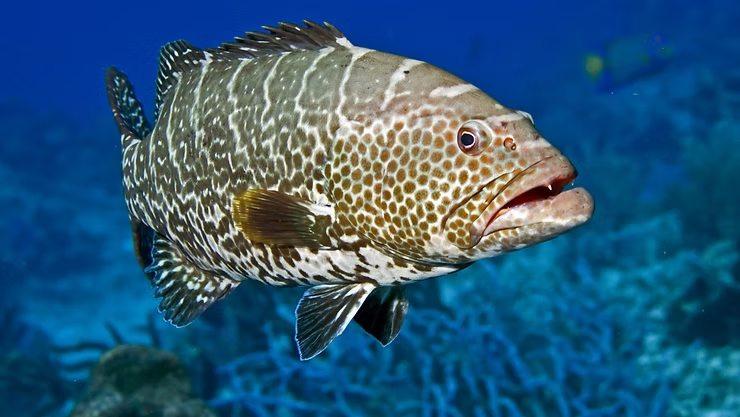Tiger Groupers in the Wild
Hunting Habits
Tiger groupers are stealthy ambush predators that use camouflage and patience to capture prey. They often remain motionless within coral reefs before launching sudden, powerful strikes to swallow fish or crustaceans whole. Their large mouths and muscular bodies make them formidable hunters in reef ecosystems.
- Hide among corals and rocks to blend in.
- Wait for unsuspecting fish to approach.
- Attack with speed and precision.
Color Variations
These fish are as stylish as they are fierce, displaying a wide range of colors and patterns. Shades can range from deep brown to sandy hues, with stripes or spots resembling a tiger’s markings. Some groupers even show yellow, white, or reddish tones, enhancing both camouflage and communication in their environment.
Unique Features
Beyond their vibrant appearance, tiger groupers stand out for their impressive size and intelligence. They can grow large and are sometimes observed using rocks to break open hard-shelled prey. Each individual showcases distinct markings, adding to the species’ uniqueness.
- Distinctive stripes and spotted patterns.
- Large size and robust build.
- Innovative feeding strategies, including tool use.
Conservation Efforts
Protecting Habitats
Healthy coral reefs and mangroves are essential for tiger groupers. Conservation strategies focus on restoring reefs, safeguarding marine protected areas, and monitoring water quality to ensure their survival.
Impact of Overfishing
Overfishing threatens tiger grouper populations and disrupts reef ecosystems. Removing too many predators can allow invasive species like lionfish to flourish, harming biodiversity and local economies dependent on sustainable fishing.
- Reduces natural population balance in reefs.
- Limits genetic diversity for long-term survival.
- Weakens marine ecosystems and food chains.
Tiger Groupers Compared to Other Species
Versus Lionfish
Tiger groupers play a vital role in controlling lionfish populations, one of the most invasive reef species. Their bold predation helps maintain ecological balance where lionfish would otherwise overrun habitats.
Versus Stingrays
While stingrays rely on camouflage and stingers for defense, tiger groupers depend on strength and ambush. Both species share habitats, but their survival strategies highlight the diversity of marine life.
Fishing Regulations
Seasonal Closures
Fishing restrictions, such as seasonal closures, are designed to protect tiger groupers during spawning. For example, fishing bans in certain U.S. federal waters run from February through April, covering multiple grouper species.
Legal Limits
Bag limits, size restrictions, and seasonal bans are essential tools for preventing overfishing. These regulations ensure tiger grouper populations remain stable for future generations and ecosystems.
Tiger Grouper Recipes
Grilled with Garlic Butter
A simple yet delicious recipe pairs fresh tiger grouper with garlic butter. Grilling enhances its flaky texture and natural flavors, especially when served with vegetables or a crisp salad.
Asian-Inspired Preparation
Marinated in soy sauce, garlic, and ginger, tiger grouper fillets can be steamed or pan-seared for a delicate, flavorful dish. Pairing it with rice or stir-fried vegetables creates a balanced meal.
Health Benefits
Nutritional Value
Tiger groupers provide lean protein and are rich in vitamins B12 and niacin, along with minerals like phosphorus, potassium, and selenium. They are low in calories yet nutrient-dense, making them a healthy addition to meals.
Omega-3 Benefits
Loaded with omega-3 fatty acids, tiger groupers support heart, brain, and immune health. Regular consumption can help lower blood pressure, reduce cholesterol, and combat inflammation.
Conclusion
Tiger groupers are captivating marine predators that blend beauty, ecological importance, and nutritional value. From their striking patterns to their role in balancing reef ecosystems, they remind us of the need for conservation and sustainable fishing. Protecting these fish ensures future generations can continue to admire—and enjoy—them both in the wild and on the plate.

